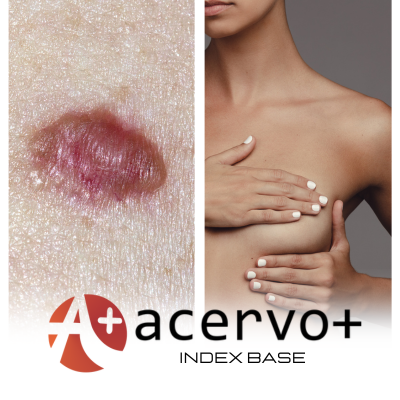Caracterização e comportamento tumoral dos subtipos moleculares do carcinoma de mama
##plugins.themes.bootstrap3.article.main##
Resumo
Objetivo: Correlacionar a influência dos subtipos moleculares no desenvolvimento e prognóstico do câncer de mama, abordando as características histopatológicas e evolutivas de cada classificação, relacionando assim caracterização da expressão gênica por meio de métodos de cDNA microarray e imuno-histoquímica, além do desenvolvimento de assinaturas prognósticas e preditivas. Revisão bibliográfica: O câncer de mama, por ser uma doença heterogênea, contempla-se como uma patologia complexa e multifacetada que abrange uma variedade de fatores moleculares que permitem a expressão de diferentes características clínicas, morfológicas e comportamentais. É dividido em subtipos moleculares mediante análises genéticas, sendo eles: Luminal A, Luminal B, ERBB2/HER2 amplificado, Triplo Negativo e Claudin-low. A partir da imuno-histoquímica detecta-se a presença de biomarcadores como receptor de progesterona, receptor de estrogênio, ERBB2/HER2 e Ki-67, contribuindo com a avaliação de risco, diagnóstico diferencial e prognóstico. Ademais, torna-se possível estabelecer o tratamento sistêmico ideal para cada paciente, assim como presumir a resposta terapêutica à determinada terapia. Considerações finais: As características biológicas e moleculares desses subtipos moleculares, com padrões morfológicos e imunofenotípicos diferentes, concede uma melhor compreensão dos processos de formação, manutenção e progressão dos tumores do carcinoma de mama, a fim de desenvolver uma orientação terapêutica individualizada para cada prognóstico.
##plugins.themes.bootstrap3.article.details##
Copyright © | Todos os direitos reservados.
A revista detém os direitos autorais exclusivos de publicação deste artigo nos termos da lei 9610/98.
Reprodução parcial
É livre o uso de partes do texto, figuras e questionário do artigo, sendo obrigatória a citação dos autores e revista.
Reprodução total
É expressamente proibida, devendo ser autorizada pela revista.
Referências
2. BENITEZ FUENTES JD, et al. Global Stage Distribution of Breast Cancer at Diagnosis: A Systematic Review and Meta-Analysis. JAMA Oncology, 2024; 10 (1): 71.
3. BRASIL. Ministério da Saúde, Instituto Nacional de Câncer (INCA). Controle do câncer de mama no Brasil: dados e números. 2024. Disponível em: https://www.inca.gov.br/publicacoes/livros/controle-do-cancer-de-mama-no-brasil-dados-e-numeros-2024. Acessado em: 26/02/2025
4. CHAUDHARY LN, et al. Triple-Negative Breast Cancer. Surgical Oncology Clinics of North America, 2018; 27(1): 141–153.
5. CHENG T, et al. CDKN2A-mediated molecular subtypes characterize the hallmarks of tumor microenvironment and guide precision medicine in triple-negative breast cancer. Frontiers in Immunology, 2022; 13:970950.
6. DING YC, et al. Molecular subtypes of triple-negative breast cancer in women of different race and ethnicity. Oncotarget, 2019; 10(2): 198–208.
7. FAHAD ULLAH M. Breast Cancer: Current Perspectives on the Disease Status. In: AHMAD, A. (Ed.). Breast Cancer Metastasis and Drug Resistance. Cham: Springer International Publishing, 2019. v. 1152p. 51–64.
8. FERLAY J, et al. Estimating the global cancer incidence and mortality in 2018: GLOBOCAN sources and methods. International Journal of Cancer, 2019; 144(8): 1941–1953.
9. FRAGOMENI SM, et al. Molecular Subtypes and Local-Regional Control of Breast Cancer. Surgical Oncology Clinics of North America, 2018; 27(1): 95–120.
10. JÁCOME LGR, et al. Perfil imuno-histoquímico e variáveis clinicopatológicas do câncer de mama em Roraima. Brazilian Journal of Health Review, 2024; 7(9): e75270.
11. KALININA TS, et al. Association between Lymph Node Status and Expression Levels of Androgen Receptor, miR-185, miR-205, and miR-21 in Breast Cancer Subtypes. International Journal of Breast Cancer, 2020; 2020: 1–7.
12. KARIM AM, et al. Triple-negative breast cancer: epidemiology, molecular mechanisms, and modern vaccine-based treatment strategies. Biochemical Pharmacology, 2023; 212: 115545.
13. KASHYAP D, et al. [Retracted] Global Increase in Breast Cancer Incidence: Risk Factors and Preventive Measures. BioMed Research International, 2022; 2022(1): e9605439.
14. KATSURA C, et al. Breast cancer: presentation, investigation and management. British Journal of Hospital Medicine, 2022; 83(2): 1–7.
15. LIN K, et al. The Breast Cancer Protooncogenes HER2, BRCA1 and BRCA2 and Their Regulation by the iNOS/NOS2 Axis. Antioxidants, 2022; 11(6): 1195.
16. LOPEZ-GONZALEZ L, et al. Exploring Biomarkers in Breast Cancer: Hallmarks of Diagnosis, Treatment, and Follow-Up in Clinical Practice. Medicina, 2024; 60 (1): 168.
17. ŁUKASIEWICZ S, et al. Breast Cancer—Epidemiology, Risk Factors, Classification, Prognostic Markers, and Current Treatment Strategies—An Updated Review. Cancers, 2021; 13(17): 4287
18. MATHUR P, et al. Cancer Statistics, 2020: Report from National Cancer Registry Programme, India. JCO Global Oncology, 2020; 6: 1063–1075.
19. NOLAN E, et al. Deciphering breast cancer: from biology to the clinic. Cell, 2023; 186(8): 1708–1728.
20. PAN C, et al. Research progress of Claudin-low breast cancer. Frontiers in Oncology, 2023; 13: 1226118.
21. PROVENZANO E, et al. Molecular Classification of Breast Cancer. PET Clinics, 2018; 13(3): 325–338.
22. QATTAN A, et al. Clinical Identification of Dysregulated Circulating microRNAs and Their Implication in Drug Response in Triple Negative Breast Cancer (TNBC) by Target Gene Network and Meta-Analysis. Genes, 2021; 12(4): 549.
23. RAKHA EA, et al. Assessment of Predictive Biomarkers in Breast Cancer: Challenges and Updates. Pathobiology, 2022; 89(5): 263–277.
24. ROY M, et al. Molecular Classification of Breast Cancer. PET Clinics, 2023; 18(4): 441–458. 2023.
25. SONG Y, et al. Identification of potential immunotherapy biomarkers for breast cancer by bioinformatics analysis. Bioscience Reports, 2022; 42(2): BSR20212035.
26. SOUZA KCB, et al. Identification of Cell-Free Circulating MicroRNAs for the Detection of Early Breast Cancer and Molecular Subtyping. Journal of Oncology, 2019; 2019: 1–11.
27. TURNER KM, et al. Heterogeneity within molecular subtypes of breast cancer. American Journal of Physiology-Cell Physiology, 2021; 321(2): C343–C354.

